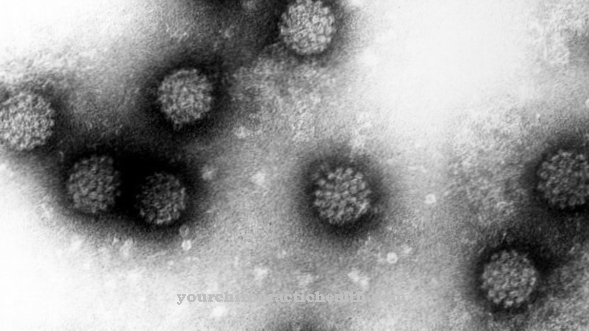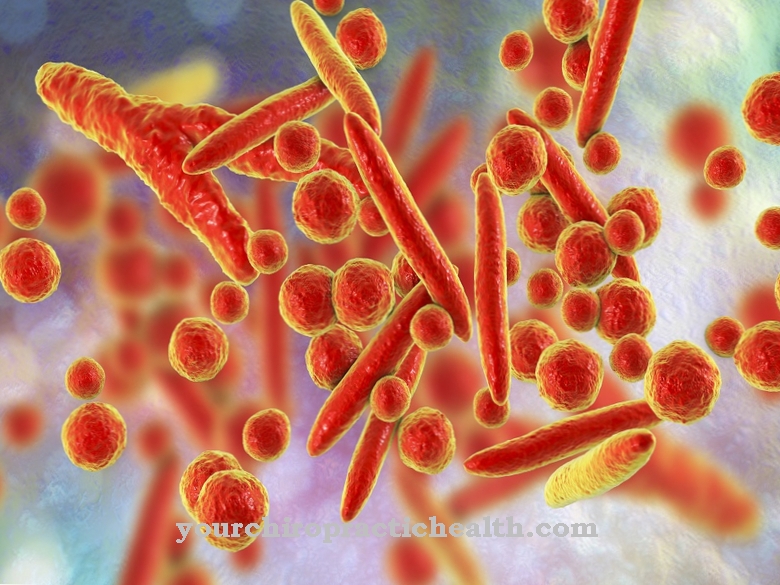Human adenoviruses are a group of DNA viruses discovered by Wallace P. Rowe in 1953. The American cancer researcher and virologist isolated the viruses from the tonsils of humans, the so-called adenoids. The term human adenoviruses is derived from this for the virus types that attack humans.
What are human adenoviruses?
Of the human adenoviruses 19 species with more than fifty serotypes are known to date. The viruses do not have a shell but a so-called capsid with a diameter of seventy to ninety nanometers. The capsid consists of regularly arranged proteins in the shape of a dodecagon with antenna-like projections at the corners.
Since human adenoviruses do not have a sensitive envelope, they can survive outside a host for a long time. The core of the virus consists of a linear, double-stranded DNA. This special form of DNA makes it very resistant to physical and chemical influences. The viruses are quite robust to alcoholic disinfectants.
They can also tolerate strongly acidic or basic pH values. However, they are quite temperature sensitive. If human adenoviruses are exposed to temperatures of 56 degrees Celsius or higher for at least ten minutes, they are completely inactivated.
Meaning & function
Of the known 19 species human adenoviruses six can cause disease in their host. However, not every infection is recognized by a long way.
Around half of all infections occur without the person affected developing any visible symptoms. Infections that develop symptoms are mild in the majority of cases. Treatment then does not take place at all or only symptomatically. In the case of more severe courses, only complications and symptoms can be treated, as there are no virus-inhibiting drugs. The severity of the course of the infection can depend on the entry point of the virus. Oral infection may be asymptomatic or mild, while inhalation infection can lead to serious illness.
Adenoviruses are transmitted through direct contact with a host or, if there is insufficient hygiene, also fecal-orally as a smear infection. Occasionally, infection can also take place via water. If human adenoviruses have penetrated the body, they usually attack the epithelial cells of the nose, throat and pharynx, as well as the lungs and the digestive tract. They also infect the eye less often. In addition to the acute infectious diseases as a result of infection, a connection between obesity and a certain serotype of adenoviruses is suspected.
Aside from their harmful effects, adenoviruses can also be used to treat diseases. With their help, for example, genetically modified vaccines can be produced against the highly dangerous Ebola virus. In cancer therapy, they help to inhibit tumor growth. Gene therapy also benefits from the viruses. For example, human adenoviruses are used in gene therapy for a specific form of muscle wasting.
Diseases
Most common by human adenoviruses the airways are affected. The extent of the infection can range from a simple cold with a runny nose and sore throat to bronchitis and pneumonia.
They are therefore of particular importance in the case of epidemic flu-like infections of varying severity. People with a particularly weak immune system run the risk of developing serious complications. For example, they can lead to acute lung failure.
If human adenoviruses settle in the digestive tract, they can cause gastrointestinal inflammation with diarrhea, nausea, vomiting and abdominal pain. In the further course of the digestive tract, they can also affect the mucous membranes of the bladder and cause cystitis.
Adenoviruses can be carried into the eye by rubbing with contaminated hands. There they lead to inflammation of the conjunctiva and cornea and to dry eyes. Often, diseases of the eye caused by these viruses result from bathing in small lakes or poorly chlorinated swimming pools.
If infections with human adenoviruses are spread, serious illnesses can result. Infection of the lungs can lead to inflammation of the cartilage-free bronchial tissue, which is associated with asthma-like symptoms. If the viruses migrate in the body, they can also cause pain in joints or disorders of the heart muscle function. A sudden hearing loss or the development of type 1 diabetes are also possible long-term consequences of an infection with human adenoviruses.

















.jpg)



.jpg)

.jpg)




